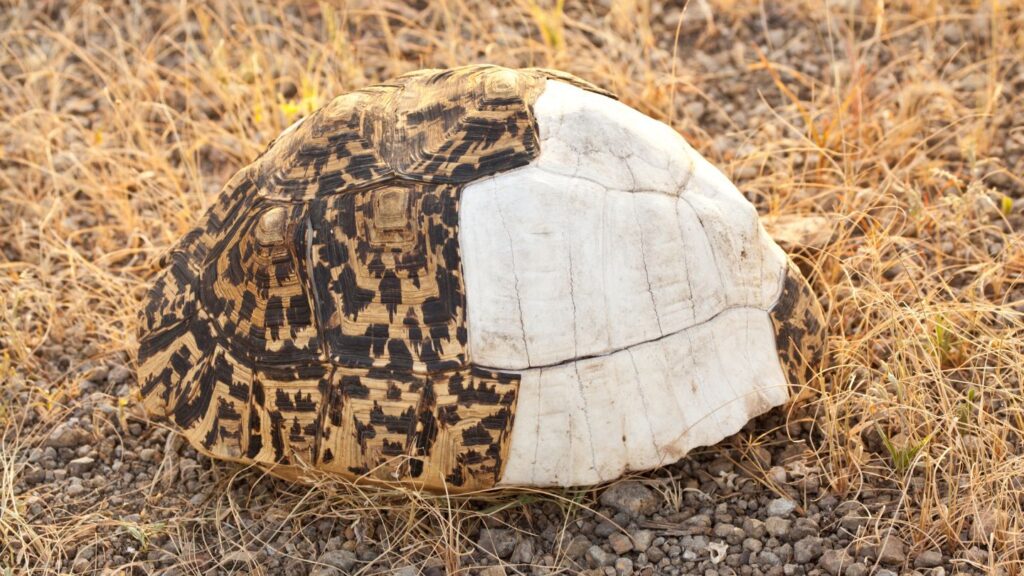In this article, we will explore all the questions “Whether Turtles and Tortoises can feel their outer shell or not?”. As per biology, Turtles and Tortoises have nerve endings (not nerves) in their shells. These nerve endings allow them to sense pressure, touch, and feel pain. However, the outer shell of Turtles and Tortoises aren’t directly connected to their central nervous system. With regard to that, these reptiles do not feel the same way humans do.
Join us in this article, and we will explore the anatomy and functions of turtle and tortoise shells. Moving forward, we will also debunk myths and misconceptions about Turtle and Tortoise. In addition, we will also highlight some fascinating facts about them. Are you ready to dive in and discover the world of turtles and tortoises?
Contents
- Do Turtles Have Any Nerves In Their Shells? Anatomy And Functions Of Turtle And Tortoise Shells
- Does A Turtle Feel Pain If Its Shell Gets Hit?
- Do Turtles Like Their Shells Touch?
- Does It Hurt A Turtle To Pick It Up By Its Shell?
- Do Turtles Like Their Shell Scratched?
- Can You Remove A Turtle From Its Shell Without Killing It?
- 5 Misconceptions About Turtle And Tortoise
- 6 Fascinating Facts About Turtles and Tortoises
- Wrapping up…
Do Turtles Have Any Nerves In Their Shells? Anatomy And Functions Of Turtle And Tortoise Shells
No, turtles do not have any nerves in their shells. Turtles’ shell, which is also known as Carapaces, is made up of a tough keratin layer and bones. The bones at Carapace are connected with turtles’ spine and ribs and thus give them strength and protection. Although their shell doesn’t contain any nerves, it has nerve endings, and turtles have highly developed nervous system.
With that, these reptiles can feel touch and pressure on their skin/ shell. Their skin is closely attached to their shell, and therefore any pressure or movement of the shell is immediately detected by the skin. This allows the turtle to respond to touch and adjust its position accordingly.
However, turtles cannot feel sensations on their shell like we humans on our skin. That is why it is important to handle them well, or mishandling can cause shell fracture/ injury. It, in some cases, can be life-threatening as well.

Does A Turtle Feel Pain If Its Shell Gets Hit?
If a turtle’ shell gets hit, the reptile can feel the pressure and vibration of the impact. This sensation can be stressful and alarming for them, making them alert.
However, since both Turtles and Tortoise do not have nerve endings in their shells, they don’t feel pain directly. Only a severe impact can make them feel pain or cause discomfort. Also, since their shells are attached to their spines and rib cages, a severe jolt can even injure their internal organs.
Can Turtles Feel It When Something Touches Their Shell?
Turtles and Tortoise have a highly sensitive nervous system, and thus they can feel pressure or vibration when something touches them. These reptiles can detect pressure, vibration, and changes in their environment. Any contact on their shell alert and stimulate their nervous system.
Do Turtles Like Their Shells Touch?
Whether or not Turtles like their shells touched depends upon their individual personality and preferences. The response to being touched can vary on the species, prior experiences, and age. Some turtles may enjoy being touched, while even a light stroke can make others feel stressed and uncomfortable.
However, in general, turtles have a protective instinct towards their shells. Due to that, they may not always love being touched. They will, in fact, take back and would avoid any kind of touch upon feeling threatened or uncomfortable.
Humans must gently and respectfully approach turtles and their body language and reactions before trying to touch them, even gently.
Also, it is important to remember that excessive handling or touching can weaken or damage turtles’ shell structure. This, as a result, can lead to different health issues. Not only that but it can also impact their ability to survive in the wild.

Does It Hurt A Turtle To Pick It Up By Its Shell?
Yes, you should never pick a Turtle by its shell since it can be stress-causing and extremely discomforting for the reptile. Picking them up by holding their shell can even cause injury. The shell of a Turtle or Tortoise is an important part of its anatomy.
The shell is basically attached to the reptile’s spine and ribcage and is quite a sensitive organ to count. Picking up Turtles by their shell repeatedly or roughly can cause wear and tear on their shell. This, in many cases, can lead to cracks, fractures, or other damage. And any kind of damage to the shell of a Turtle can compromise its ability to survive healthily in the wild and even in captivity.
Therefore while picking up a turtle, it is important to gently grasp them from the sides. Support their underside with your hand and also avoid pressuring or evening touching their tail or limbs. While picking a turtle on your hand, be as gentle and cautious as you can, or you may end up hurting them.
It is important to respect their unique anatomy and needs. It is, in fact, smart and considerate to avoid picking and handling reptiles like Turtle and Tortoise until it is very necessary.

Do Turtles Like Their Shell Scratched?
Some Turtles may enjoy having their shell/ back touched or scratched. In fact, some species, like red-eared sliders, box turtles, and painted turtles, show signs of pleasure or relaxation when their shells are gently stroked or rubbed. Scratching a turtle’s shell can be a matter of concern on how roughly you are doing that.
A gentle back scratch may be enjoyed by some Turtles, maybe your pet who is habitual of getting it. But when their shells are scratched too roughly, Turtles, in general, may become too stressed and threatened. Some of them may even become agitated or defensive after feeling threatened.
Suppose you want to scratch a turtle’s back start by approaching your turtle slowly and gently. Observe their behavior, and if they feel relaxed and comfortable, you can rub them gently. However, if the turtle seems uneasy or starts to retreat into its shell, stop touching them right away.
Can You Remove A Turtle From Its Shell Without Killing It?
Can Turtles Leave Their Shell? Shell is a vital body part of Turtles, and thus they cannot leave it. Turtle’s shell is attached to its body (spine and ribcage). Their shell is basically made of two parts, Carapace (the upper part) and Plastron (the lower part). As leaving any part of our body will cause immense pain, leaving their shell will make the same impact on Turtles.
In fact, it is not possible to remove a turtle’s shell without killing it. Shell is an integral part of a turtle’s body, and it is meant to provide protection to its internal organs.
If someone removes the shell of a turtle, it can cause significant damage to the reptile’s body, most likely leading to death. Let alone remove the shell; picking or handling their shell to can cause series damage.
Can ‘Painted Turtles’ Feel Their Shell?
Painted turtles (Native Turtles of North America), like all turtles, have nerve endings and sensory receptors in their shells. These nerve endings make them feel pressure, touch, and possibly temperature and environment changes.
Can Turtle Feel Emotions?
There is not enough scientific evidence that can support whether turtles, Tortoise, or other reptiles can feel emotions like mammals. Turtles, or other reptiles for that matter, do have emotional responses like fear, aggression, social bonding, etc. However, it is unclear whether these emotions are driven as instinctual responses to environmental stimuli or through any kind of emotional experience.
While it is possible that reptiles may have some basic emotions, there isn’t enough evidence to support the idea. Their capacity for complex emotions such as love, empathy, or sadness is very unclear. More studies and research would be needed in this context.
Can Turtle Feel Barnacles?
Turtles do not have the ability to feel barnacles. Barnacles are basically crustaceans that attach themselves to rocks, boats, turtles, or similar hard surfaces. Turtles have a hard exoskeleton for body protection, but they do not have nerves attached to the shell that would allow them to sense touch or pain.
However, barnacles on a turtle’s shell can cause discomfort and pressure and even generate some health issues. As heavy infestations of barnacles increase the weight of the turtle, these reptiles find it hard to swim or sometimes even more.
This, as a result, causes stress on their muscles and joints resulting in fatigue and decreased mobility. Barnacles on a turtle’s shell can even lead to damage and infection.

5 Misconceptions About Turtle And Tortoise
Here are some of the common Myths and Misconceptions related to Turtle and Tortoises.
- Turtles can leave their shells: It is one of the most common misconceptions. However, Turtles cannot leave their shells simply because it is an unremovable parts of their body. Their shell may appear like a cap to humans, but it is not. It, in fact, is made up of fused bones.
- Tortoises are slow: Tortoises are known for their speed due to a renowned story, but they aren’t that slow. Some species of tortoises can move surprisingly quickly. In fact, you can make your pet tortoise move fast as you motivate them.
- Turtles and tortoises can live in small aquariums: Turtles and tortoises require big space to move around, and a small aquarium isn’t suitable for them. Especially once the reptile grows, it will need space to explore and bask in the sun. Their aquarium should also have specialized lighting and heating, which will help them stay healthy.
- Turtles and tortoises do not need veterinary care: Both these reptiles do need veterinary care when they become sick or injured. In fact, if you have a pet reptile ensure Regular check-ups with a reptile veterinarian.
- Turtles and tortoises are easy to care for: While both of them make great pets, they aren’t very easy to care for. In fact, looking after their diet, housing, and environmental conditions take a lot of effort and knowledge.
6 Fascinating Facts About Turtles and Tortoises
- Tortoises are ancient, and they can live for more than 100 years.
- Turtles can live in most climates, almost anywhere except Antarctica.
- As simple and fascinating as it may seem, the Turtles’ shell is very complex and is made of 60 interconnected bones.
- Turtles, when going into their shell, can hold oxygen for a long time.
- Turtles smell with the roof of their mouth.
- All Tortoise are turtles, but not all turtles are Tortoise.
Wrapping up…
That was all about the shell of Turtles and Tortoises. If you have a Turtle at home (As a pet) or find one in the wild, never touch/ pick them through their shell. If you are doing so, stop the practice right now or you may end up hurting the poor reptile.
![Can Turtles And Tortoises Feel Their Outside Shell? [101 Shell Facts]](https://oxfordpets.com/wp-content/uploads/2023/03/Can-Turtles-And-Tortoises-Feel-Their-Outside-Shell.jpg)